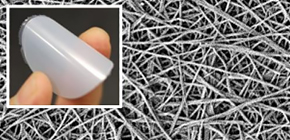
Thermally conductive paper developed!
A research group led by Kojiro UETANI at the Institute of Scientific and Industrial Research developed paper materials called “nanocellulose sheets” with high thermal conductivity by using cellulose derived from natural biomass resources in 2015, a world first. In particular, nanocellulose sheets made of nanofiber derived from tunicate of ascidian ( Halocynthia roretzi ) showed high thermal conductivity, about 10 times higher than that of plastic films. (published in Biomacromolecules on July 2, 2015) *1 These materials, seeds for future industrial materials, will be used as a base material to enable heat dissipation from high-density packaged electronic devices.
Cellulose used for paper and clothes has been thought to be a thermal material. Conventional cellulose fibers with a pulp structure that tends to contain air are used for insulating papers and as thermal insulation materials, exerting high heat insulation capabilities. For that reason, the heat-conducting properties of cellulose have not drawn much attention and been well understood.
In 2015, the research group extracted spontaneously formed cellulose nanofibers, produced high-density nanocellulose sheets, and measured their thermal conductivity. Nanocellulose sheets made of ascidian tunicate showed high thermal conductivity, about 10 times higher than that of plastic films, overturning the image that cellulose is an insulation material. This high performance is thought to be due to high crystallinity, or extended-chain crystals of cellulose molecules. The group clarified the hidden properties of cellulose.
Later, the research group fabricated thermally conductive and optically transparent flexible films with flexible nanocellulose skeletons (published in the Journal of Materials Chemistry C on October 4, 2016) *2 and paper that controls heat flux by controlling fiber orientation. (published in the ACS Macro Letters on March 20, 2017) *3
From the results of these studies, it is anticipated that cellulose, which was conventionally known as an insulator, can also be used as a heat transfer material in a wide range of thermal applications. For example, cellulose will be used as heat diffusion sheets that can efficiently exhaust heat from flexible electronic devices and heat sensitive fabric for clothes, bedclothes, and medical devices, which quickly make the user feel warm or cool.

Figure 1
Articles
- *1 “Crystallite Size Effect on Thermal Conductive Properties of Nonwoven Nanocellulose Sheets” published in Biomacromolecules on July 2, 2015 DOI: https://doi.org/10.1021/acs.biomac.5b00617
- *2 “Thermally conductive and optically transparent flexible films with surface-exposed nanocellulose skeletons” published in Journal of Materials Chemistry C on October 4, 2016 DOI: https://doi.org/ 10.1039/C6TC03318K
- *3 “In-Plane Anisotropic Thermally Conductive Nanopapers by Drawing Bacterial Cellulose Hydrogels” published in ACS Macro Letters on March 20, 2017 DOI: https://doi.org/10.1021/acsmacrolett.7b00087
- “Thermal conductivity analysis and applications of nanocellulosematerials” published in Science and Technology of Advanced Materials on November 3, 2017 DOI: https://doi.org/10.1080/14686996.2017.1390692
Related links

